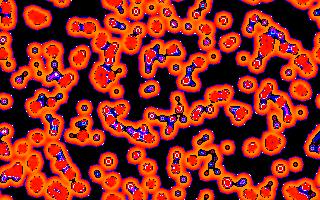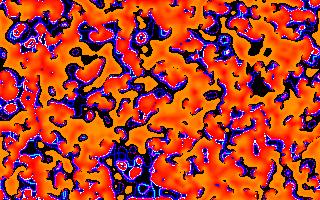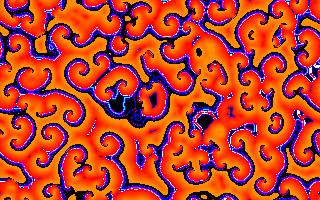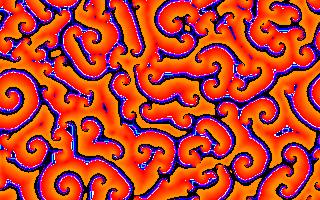

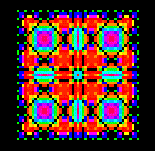
(For a general treatment of Dynamical Systems see the Essay on Dynamical Systems )
Remark : In Reality the Dynamical Law follows from certain properties of the system elements, while in a computer simulation we create these properties (of the elements) by explicitly programming of a dynamical law (in our case a CA rule). In this way we transform the elements into (dynamical) system elements.
So a CA (on a computer) is just a simulation (of a certain formal deductive structure).
But when we're actually dealing with CA's we always have in mind one or another, albeit sometimes vague, interpretation of them in terms of real-world processes.
Their simplicity and transparency will help us understand those real-world processes.
Time t Time t+1
L C R Update of central cell (C)
0 0 0 1
0 0 1 0
0 1 0 0
0 1 1 0
1 0 0 1
1 0 1 1
1 1 0 0
1 1 1 1
In the left part of this table all possible ' 3-neighborhoods ' are given. On the right side we see the Dynamical Law sensu stricto.
If the 3-neighborhood of the cell in question is 0 0 0, then the next state of this cell becomes : 1.
If the 3-neighborhood of the cell in question is 0 0 1, then the next state of this cell becomes : 0.
If the 3-neighborhood of the cell in question is 0 1 0, then the next state of this cell becomes : 0,
etc.
Then a next cell is examined in the same way, and its update determined accordingly, till all cells of the grid are thus examined an their update determined. The new states which will be attributed to the cells are temporarily stored in the computer memory. Only after the whole grid is examined all the new states will actually be attributed to the cells, and then the system passes to a new system state.
The state transition rule (the Dynamical Law, sensu stricto) in this example is :
10001101, but it could also (in an other example) be, say, 0110100, or whatever configuration.
In the case of CA's of the type of the example given, there is a total of 28 (= 2 to the power of eight) = 256 possible state transition rules, and thus 256 different CA's of this type (But a large number of them are equivalent with respect to the dynamical behavior, because of the occurrence of symmetries in CA's).
After such a simultaneous update we thus obtain a new cell pattern (a pattern of cell states), and then, at the next time step, the same state transition rule is applied again to this new pattern, i.e. to each cell for its new update, in other words, the new system state (cell pattern) now serves as an initial condition, and to this condition the rule will again be applied. And the (out of that) resulting new system state is again the initial condition to which the rule will again be applied, and this will be continued (as long as one wishes) : The system is a recursive system. Such a repeated appliance of a same rule to successive newly generated system states is called the iteration of the system.
One grid pattern after another unfolds itself, until the system finally settles itself onto one or another periodic behavior or onto a steady state : the system has reached an attractor. A steady state means that the system ends up in the same system state with every new update.
When the number of cells (system elements), N, is finite, then binary CA's (CA's whose cells can only be in one, out of two, cell states) show 2N (= 2 to the power of N) possible configurations (patterns of on / off cells), and that is a finite number (when N is finite), and consequently sooner or later a system state will be visited, which was already visited by the system before. From that point in time on, the system is situated on a periodic cycle : The same state of affairs (i.e. the same sequence of system states) will repeat itself indefinitely. Such a cycle we call -- as stated earlier -- an attractor of the system (generally one out of the many attractors of the system). From other initial conditions the system could reach other attractors.
Remark : It was formerly supposed that every human body cell contains about 100000 genes. Very recently, however, it became clear that this number should be somewhere between 30000 and 40000.
Thus, again, suppose that we have a (CA-)grid of just 400 cells. And suppose that every cell can be either, say, white or black (think of a simple model of genes, which are either on, or off). Thus we suppose a binary CA with system size = 400. How many patterns of black-and-white cells (every pattern consisting of 400 cells) are in this case possible? It turns out that there are 2400, which is about 10100, possible patterns.
To get an idea how big this number is, one has only to realize that it is much bigger than the number of Hydrogen atoms in the Universe (that number is about 1060)!
When the system (the supposed CA), on the basis of an initial condition plus a rule, starts running, then it goes from one configuration (of cell states) to the next one. This succession of system states is called a trajectory of the dynamical system in its State Space. That State Space generally is, as has been showed, very large. But when the system is orderly, then the system will quickly settle on a small attractor, a cycle with a small period, say, a period of 20. And from now on the system keeps cycling, which means that after having visited 20 system states, the system starts again with successively visiting those same 20 system states, and this repeats itself indefinitely. The system thus finally abides in a very small corner of its State Space : It now keeps visiting only 20 states of the possible 10100! This number is a one with 100 zeros :
10000000000000000000000000000000000000000000000000000000000000000000000000000000000000000000000000000
From another (different) initial condition the system could proceed to another cycle (i.e. another attractor).
The Basin of Attraction Field (= Attraction-basin Field)
When we have a certain CA, and thus a certain CA-rule (state transition rule, Dynamical Law), then such a rule implies determined transitions between system states (note : the transitions between cell states -- determined by the state transition rule -- determine the transitions between system states ). So this state transition rule supplies the state space (= the collection of all possible system states) with structure, because it establishes connections between those system states. The result is a Basin of Attraction Field (see for this concept also : the Essay on Dynamical Systems, section The Essence and the Attraction-basin Field). Such an attraction-basin field consists of interconnected system states : we see system states connected with each other to form cycles, and we see sequences of system states leading to one or another such cycle. All the system states, leading to a particular attractor, say attractor A, form, together with the system states of the attractor itself, the Basin of Attraction of attractor A. The total of all the attraction-basins, that the system admits, forms the Attraction-basin Field of that system. This Attraction-basin Field thus documents all possible behavior of the Cellular Automaton, provided with the given state transition rule, and is as such equivalent to this rule. This rule is seated at a low level of the system, while the attraction-basin field is seated at a global level of the system.
Cellular Automata can serve as simulations of all kinds of real processes at a low structural level (some physical and chemical processes).
The ' process ' of a CA can lead to system states, which show an ordering, thus an ' organization ' of system elements into a definite pattern (Grid patterns, most clearly visible in 2-dimensional CA's (i.e. in CA's which have a two-dimensional cell grid, which thus looks like a checker-board)). This pattern can remain constant (steady state) or it can, together with a number of other patterns, form a cycle.
In such a CA the interaction of system elements is simulated, and these interactions can lead to self-organization of those system elements towards a coherent pattern.
In the figures we see such patterns being generated, by a 2-dimensional CA, with a rule called " Hodge ". The figures are (not immediately) successive system states (reading the figures from top to bottom). When this CA is running, the pattern is in constant motion, and reminds us strongly of the patterns we observe in a real, particular (chemical) system, called the Belousov-Zhabotinsky Reaction.


